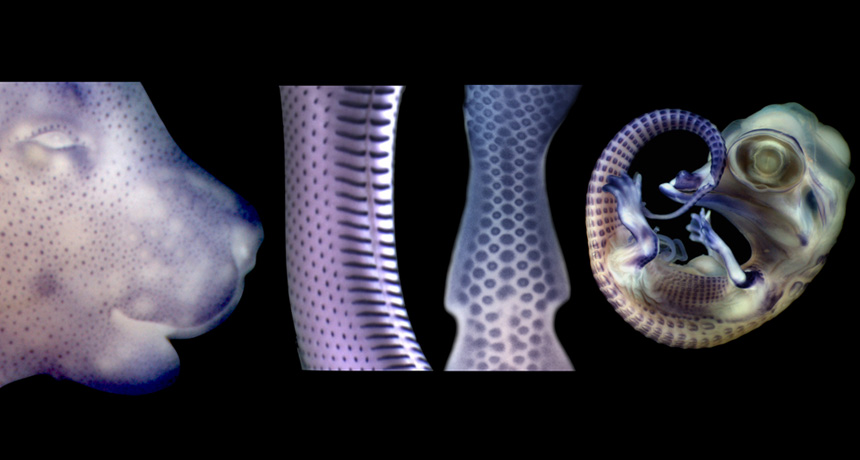Reptile scales share evolutionary origin with hair, feathers

Hair, scales and feathers arose from one ancestral structure, a new study finds.
Studies in fetal Nile crocodiles, bearded dragon lizards and corn snakes appear to have settled a long-standing debate on the rise of skin coverings. Special skin bumps long known to direct the development of hair in mammals and feathers in birds also turn out to signal scale growth in reptiles, implying all three structures evolved from a shared ancestor, scientists report online June 24 in Science Advances.
In embryonic birds and mammals, some areas of the skin thicken into raised bumps. Since birds evolved from ancient reptiles, scientists expected that modern snakes, lizards and crocodiles would have the same structures. A study at Yale University last year found that one protein already known to be important in hair and feather development is also active in the skin of developing alligators. But the team did not find the telltale skin thickening. Without that evidence from modern reptiles, scientists weren’t sure if the bumps had been lost in reptiles, or if birds and mammals had evolved them independently, using the same set of genes.
The new results are “a relief,” says Michel Milinkovitch, whose lab led the new study at the University of Geneva. Scientists had come up with a variety of complicated ideas to explain how birds and mammals could share a structure that reptiles lack. But, he says, “the reality is much simpler.”
Clues from a mutant lizard inspired Milinkovitch’s team to probe the mystery. Nicolas Di-Poï, a coauthor of the new study who is now at the University of Helsinki, found that a hair-development gene called EDA was present, but disrupted, in scaleless, or “silky,” bearded dragons. Di-Poï and Milinkovitch searched for similar molecular signals in normal reptile embryos and found genes and proteins associated with hair and feather growth studding the skin. Cell staining revealed characteristic skin thickening at those signal centers.
Reptilian skin bumps eluded previous researchers because they are tiny, appear briefly and don’t all come in at once as they do in mammals, Milinkovitch speculates. “You have to look in the right place at the right time to see them,” he says. “Then boom, you see them, and you’re like, ‘Whoa, they are exactly the same.’”
This study “addresses a fundamental question about identity for skin structures,” says paleontologist Marcelo Sánchez of the University of Zurich, who was not involved in the new research. It’s especially important that the team used crocodiles, lizards and snakes, which are far from typical lab animals, he says. Using nonmodel organisms “gives new insight into evolution we wouldn’t get otherwise.”
The next step is to understand how hairs, feathers and scales diversified from the same ancestral structure. That primordial body covering wasn’t necessarily a scale, says evolutionary biologist Günter Wagner, an author of the 2015 Yale study. “Even though intuitively you would think reptilian-like skin is ancestral, compared to mammals,” he says “it’s entirely unclear what kind of structure the scales and feathers on the one side and hair on the other has evolved from.”